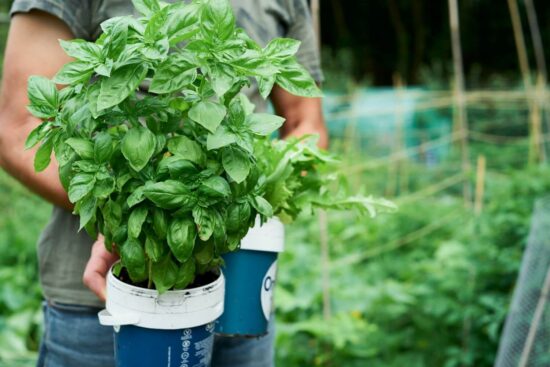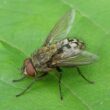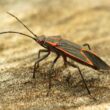Nothing beats the fresh taste of homegrown basil in your favorite recipes. But when you head out to harvest some leaves and find them full of holes, it can be pretty frustrating. The good news? You don’t have to give up and let the bugs win. Learning how to stop bugs from eating basil is easier than you might think.
Here are some proven ways to keep bugs away from your basil plants and get back to enjoying fresh herbs in your cooking.
1. Use Physical Barriers and Protection Methods
Sometimes the simplest solution is the best one. Physical barriers create a wall between your basil plants and hungry pests, and they work really well when set up correctly. If you’re wondering how to stop insects from eating basil, starting with barriers is often the most effective first step.
Row Covers and Netting: Floating row covers are lightweight fabrics that let light, air, and water through while keeping bugs out. You can drape them directly over your basil plants or attach them to hoops for extra space. Make sure to anchor the edges with landscape staples, bricks, or soil so pests can’t crawl underneath.
Install these covers early in the growing season before pests become active. This prevents them from laying eggs on your plants in the first place. You can remove the covers once your basil is well-established, or keep them on all season for maximum protection.
Elevated Containers: Growing basil in pots raised off the ground makes it much harder for crawling pests like slugs, snails, and earwigs to reach your plants. Place containers on bricks, pot feet, or plant stands with at least 6 inches of clearance. This also eliminates dark hiding spots where pests like to hang out during the day.
Sticky Traps: Yellow sticky cards catch flying insects like whiteflies, aphids, and thrips. Place them near your basil plants at leaf level and replace them when they get covered with bugs. While these won’t solve a major infestation on their own, they’re great for monitoring pest activity and catching problems early.
Studies show that properly installed row covers can reduce pest damage by 85 to 90 percent. That’s pretty impressive protection for such a simple method.
2. Apply Organic Sprays for Multiple Pests
Organic sprays are safe, effective, and easy to make at home. They work by disrupting pest life cycles, making plants taste bad, or physically harming soft-bodied insects. When considering how to stop bugs from eating basil naturally, these homemade solutions are among your best options.
Neem Oil Spray: Neem oil comes from the neem tree and has been used as a natural pesticide for hundreds of years. It messes with insect hormones, stops them from feeding properly, and prevents them from reproducing normally.
Mix 1 to 2 tablespoons of neem oil with 1 teaspoon of mild dish soap in a gallon of water. The soap helps the oil mix with water and stick to leaves better. Spray your basil plants thoroughly, making sure to get the undersides of leaves where many pests hide.
Insecticidal Soap: Pure castile soap creates a solution that suffocates soft-bodied insects and breaks down their protective waxy coating. Mix 1 to 2 tablespoons of pure castile soap (like Dr. Bronner’s) in a gallon of water. Avoid using dish soap or other cleaners that might harm your plants.
Garlic and Pepper Spray: This homemade spray creates a strong smell and taste that many insects hate. Blend 2 whole garlic bulbs and half a cup of hot peppers with a small amount of water. Let it sit overnight, then strain out the solids and add enough water to make a gallon. Add a few drops of mild soap to help it stick to leaves.
Application Tips: Always spray in the early morning or evening when beneficial insects are less active. Cover both the tops and undersides of leaves since many pests hide underneath. Reapply after rain or heavy watering. Test any new spray on a small area first to make sure it won’t damage your plants.
With regular application, these organic sprays can control 70 to 90 percent of soft-bodied pests.
3. Use Diatomaceous Earth as a Natural Pesticide
Diatomaceous earth (DE) might sound fancy, but it’s actually just fossilized algae ground into a fine powder. The microscopic particles have sharp edges that cut through the waxy coating on insect bodies, causing them to dry out and die.
This method works great because it’s purely mechanical. Insects can’t build up resistance to it like they can with chemical pesticides. It’s also completely safe for humans and pets when you use food-grade DE.
How to Apply: Sprinkle a thin layer of food-grade diatomaceous earth around the base of your basil plants and on any mulch. You can also dust it lightly on the leaves if you’re dealing with leaf-eating pests, but this isn’t usually necessary for basil.
Important Tips: Only use food-grade DE, not the kind made for swimming pool filters. Pool-grade DE has been heat-treated and can be harmful. Avoid breathing the dust when applying it by wearing a simple dust mask or applying it when there’s no wind.
The biggest downside to DE is that it only works when dry. Rain or heavy watering washes it away, so you’ll need to reapply it regularly during wet periods.
DE is highly effective against ground-dwelling pests like slugs, snails, ants, and any crawling insects with hard outer shells.
4. Hand Pick and Remove Larger Pests
This might not be the most glamorous method, but hand-picking pests is 100 percent effective for the bugs you remove. It’s also free and gives you a chance to really look at your plants and catch problems early.
Daily Inspections: Check your basil plants every morning and evening if possible. Look for visible pests, eggs, and damage. Many pests are more active during cooler parts of the day, so you’re more likely to spot them during these times.
What to Look For: Japanese beetles are easy to spot because of their metallic green-bronze color and larger size. Caterpillars often hide on the undersides of leaves during the day. Slugs and snails come out at night, so use a flashlight for evening pest hunts.
Removal Method: When you find pests, drop them into a container of soapy water. The soap makes it impossible for them to escape and quickly kills them. Wear gloves if you’re squeamish about touching bugs or if you’re dealing with spiny caterpillars.
Egg Removal: Don’t forget to look for and remove egg masses. Many pests lay clusters of eggs on the undersides of leaves. Removing these prevents the next generation of pests from hatching on your plants.
Hand-picking works best when combined with other methods. It’s especially effective for larger, visible pests that might not be controlled well by sprays or other treatments. Many gardeners find this direct approach to how to stop insects from eating basil gives them better control over their pest problems.
5. Encourage Natural Pest Control
Nature has its own pest control system built in. By creating a garden environment that attracts beneficial insects and uses companion plants, you can get help fighting pests without lifting a finger.
Companion Plants: Certain plants naturally repel pests or make it harder for them to find your basil. Marigolds are probably the most famous companion plant because they release chemicals that many insects hate. They’re especially good at keeping aphids and nematodes away.
Nasturtiums work as “trap crops” by attracting pests away from your basil. Aphids and other insects prefer nasturtiums over basil, so they’ll go for the nasturtiums instead. Chives, garlic, and other alliums (onion family plants) also repel many insects with their strong smell.
Plant these companions within 2 to 3 feet of your basil for the best effect. You can interplant them in the same bed or grow them in nearby containers.
Beneficial Insects: Ladybugs, lacewings, and parasitic wasps are like tiny pest control experts that work for free. They eat huge numbers of aphids, caterpillars, and other harmful insects.
To attract these helpful bugs, plant flowers that provide nectar and pollen. Zinnias, calendula, cosmos, and sunflowers are all great choices. Try to have something blooming throughout the growing season to keep beneficial insects around.
Avoid using broad-spectrum pesticides that kill good bugs along with the bad ones. Even organic pesticides can harm beneficial insects if used incorrectly.
Creating Habitat: Beneficial insects need places to hide, rest, and overwinter. Leave some areas of your garden a little wild with native plants and don’t clean up everything in the fall. Small brush piles, rock gardens, and diverse plantings all provide homes for helpful insects.
This natural approach takes a little time to work, but it can reduce pest pressure by 30 to 60 percent as part of an overall pest management plan. Plus, it creates a healthier, more balanced garden ecosystem. Understanding how to stop bugs from eating basil includes working with nature rather than against it.
6. Control Slugs and Snails Specifically
Slugs and snails can be some of the most frustrating basil pests because they do their damage at night when you can’t see them. You might go to bed with perfect plants and wake up to find them full of holes. Here are three effective ways to deal with these slimy pests.
Beer Traps: Slugs and snails are attracted to the yeast in beer. Bury shallow containers like tuna cans or jar lids so the rim is level with the soil surface. Fill them with cheap beer (the expensive stuff works too, but why waste it?).
Place traps about 2 to 3 feet away from your basil plants. If you put them too close, you might actually attract more slugs to the area. Check the traps every few days and empty them out. Refresh the beer every 2 to 3 days or after rain.
Crushed Eggshells: Clean, dry eggshells create a rough barrier that slugs and snails don’t like to cross. Crush them into small pieces and scatter them around the base of your basil plants. The sharp edges irritate their soft bodies.
This method works best when combined with others since determined slugs will sometimes cross the shells anyway. Reapply monthly or after heavy rain that might wash the shells away.
Iron Phosphate Slug Bait: This organic slug bait contains iron phosphate, which is safe for pets, wildlife, and beneficial insects but deadly to slugs and snails. Popular brands include Sluggo and Escar-Go.
Scatter the pellets around your plants according to the package directions. Slugs and snails eat the bait and stop feeding almost immediately, then die within a few days. This method works even in wet conditions, unlike some other slug controls.
Avoid slug baits that contain metaldehyde, which can be harmful to pets and other animals.
Using a combination of these methods can control 70 to 95 percent of slug and snail problems, with iron phosphate being the most effective single approach.
7. Maintain Proper Plant Health and Spacing
Healthy basil plants can defend themselves much better than stressed, weak plants. Pests often target plants that are already struggling, so keeping your basil happy and healthy is one of the best pest prevention strategies.
Proper Watering: Basil likes consistent moisture but not soggy soil. Water when the top inch of soil feels dry, and water deeply rather than frequently. Overwatering creates conditions that attract fungus gnats and can lead to root problems that make plants more vulnerable to pests.
Good drainage is essential. If water pools around your plants, improve drainage by adding compost or growing in raised beds or containers.
Adequate Sunlight: Basil needs at least 6 hours of direct sunlight per day to grow strong and healthy. Plants grown in too much shade become weak and spindly, making them easy targets for pests.
If you’re growing indoors, place basil in a south-facing window or supplement with grow lights.
Proper Spacing: Space basil plants 12 to 16 inches apart to allow good air circulation. Crowded plants create humid conditions that many pests love. Good airflow also helps prevent fungal diseases that can weaken plants and attract pests.
Fertilizing: Feed basil regularly with a balanced fertilizer, but don’t overdo it. Too much nitrogen creates soft, succulent growth that aphids and other pests find irresistible. Follow package directions and err on the side of less rather than more.
Pruning and Maintenance: Remove damaged, diseased, or pest-infested leaves promptly. Pinch off flower buds to keep the plant producing flavorful leaves rather than going to seed. Regular harvesting actually helps keep plants healthy and productive.
Healthy plants are 40 to 60 percent more resistant to pest problems than stressed plants. This makes proper care one of your most important pest prevention tools.
8. Practice Regular Garden Sanitation
A clean garden is a less pest-friendly garden. Many insects overwinter in plant debris, weeds, and other hiding spots around your garden. Regular cleanup eliminates these pest hotels and reduces problems next season.
Weekly Cleanup: Remove fallen leaves, dead plant material, and weeds from around your basil plants at least once a week during the growing season. These create hiding spots for pests and can harbor eggs and larvae.
Pay special attention to areas under and around containers where pests like to hide during the day.
Tool Hygiene: Clean your gardening tools between plants to avoid spreading pests and diseases. A simple spray with rubbing alcohol or a dip in a bleach solution (1 part bleach to 9 parts water) does the job.
Compost Management: Keep compost piles away from your growing areas. While compost is great for soil health, active piles can attract pests. Use finished compost that has been properly heated to kill pest eggs and larvae.
Mulch Considerations: Mulch helps retain moisture and suppress weeds, but it can also provide hiding places for slugs, snails, and other pests. If you’re having major slug problems, consider removing mulch temporarily or using less pest-friendly options like gravel or cocoa hulls.
Fall Cleanup: Clean up thoroughly at the end of the growing season. Remove all plant debris, fallen fruit, and other organic matter where pests might overwinter. This breaks their life cycle and reduces problems next year.
Crop Rotation: If you grow basil in the same spot every year, consider moving it to a different location. This disrupts pest cycles and prevents soil-dwelling problems from building up.
Regular sanitation can reduce pest populations by 30 to 50 percent. It’s not the most exciting garden task, but it’s one of the most important for long-term pest management.


